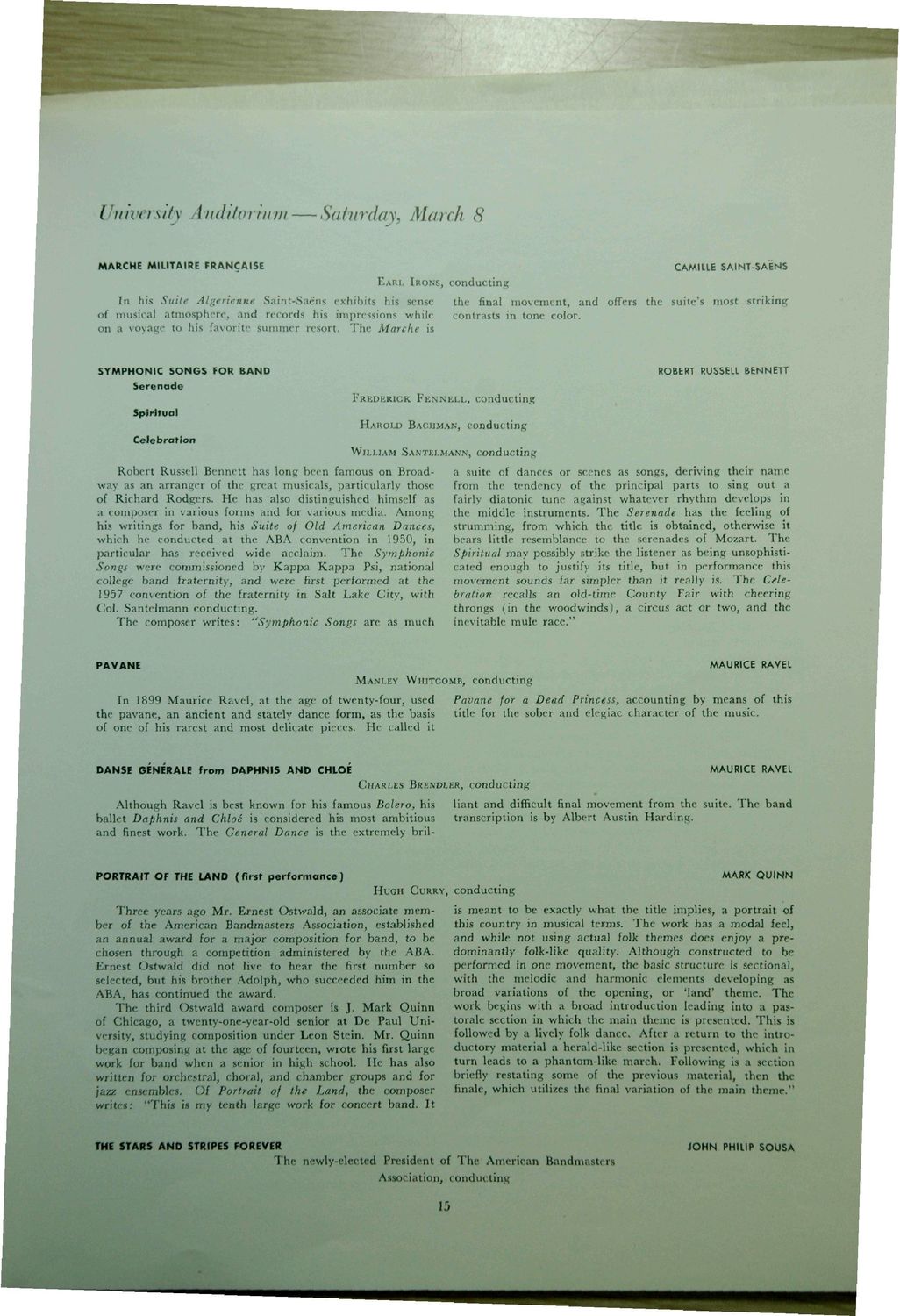Caption: Dedication - Band Building - Band Master's Association
This is a reduced-resolution page image for fast online browsing.

EXTRACTED TEXT FROM PAGE:
University Auditorium—Saturday. MARCHE M1L1TAIRE FRANCAISE March 8 CAMHLE SAINT-SAENS EARL IRONS, conducting In his Suite Algerienne Saint-Saens exhibits his sense of musical atmosphere, and records his impressions while on a voyage to his favorite summer resort. The Marche is the final movement, and offers the suite's most striking contrasts in tone color. SYMPHONIC SONGS FOR BAND Serenade Spiritual Celebration FREDERICK FEN N ELL, conducting HAROLD BACHMAN, conducting WILLIAM SANTELMANN, conducting ROBERT RUSSELL BENNETT Robert Russell Bennett has long been famous on Broadway as an arranger of the great musicals, particularly those of Richard Rodgers. He has also distinguished himself as a composer in various forms and for various media. Among his writings for band, his Suite of Old American Dances, which he conducted at the ABA convention in 1950, in particular has received wide acclaim. The Symphonic Songs were commissioned by Kappa Kappa Psi, national college band fraternity, and were first performed at the 1957 convention of the fraternity in Salt Lake City, with Col. Santelmann conducting. The composer writes: "Symphonic Songs are as much a suite of dances or scenes as songs, deriving their name from the tendency of the principal parts to sing out a fairly diatonic tunc against whatever rhythm develops in the middle instruments. The Serenade has the feeling of strumming, from which the title is obtained, otherwise it bears little resemblance to the serenades of Mozart. The Spiritual may possibly strike the listener as being unsophisticated enough to justify its title, but in performance this movement sounds far simpler than it really is. The Celebration recalls an old-time County Fair with cheering throngs (in the woodwinds), a circus act or two, and the inevitable mule race." PAVANE MANLEY WHITCOMB, conducting MAURICE RAVEL In 1899 Maurice Ravel, at the age of twenty-four, used the pavane, an ancient and stately dance form, as the basis of one of his rarest and most delicate pieces. He called it DANSE GENERALE from DAPHNIS AND CHLOE Pavane for a Dead Princess, accounting by means of this title for the sober and elegiac character of the music, MAURICE RAVEL CHARLES BRENDLER, conducting Although Ravel is best known for his famous Bolero, his ballet Daphnis and Chloe is considered his most ambitious and finest work. The General Dance is the extremely bril- liant and difficult final movement from the suite. The band transcription is by Albert Austin Harding, PORTRAIT OF THE LAND (first performance) HUOH CURRY, conducting MARK QUINN Three years ago Mr. Ernest Ostwald, an associate member of the American Bandmasters Association, established an annual award for a major composition for band, to be chosen through a competition administered by the ABA. Ernest Ostwald did not live to hear the first number so selected, but his brother Adolph, who succeeded him in the ABA, has continued the award. The third Ostwald award composer is J. Mark Quinn of Chicago, a twenty-one-year-old senior at De Paul University, studying composition under Leon Stein. Mr. Quinn began composing at the age of fourteen, wrote his first large work for band when a senior in high school. He has also written for orchestral, choral, and chamber groups and for jazz ensembles. Of Portrait of the Land, the composer writes; "This is my tenth large work for concert band. I t is meant to be exactly what the title implies, a portrait of this country in musical terms. The work has a modal feel, and while not using actual folk themes does enjoy a predominantly folk-like quality. Although constructed to be performed in one movement, the basic structure is sectional, with the melodic and harmonic elements developing as broad variations of the opening, or 'land* theme. The work begins with a broad introduction leading into a pastorale section in which the main theme is presented. This is followed by a lively folk dance. After a return to the introductory material a herald-Hke section is presented, which in turn leads to a phantom-like march. Following is a section briefly restating some of the previous material, then the finale, which utilizes the final variation of the main theme." THE STARS AND STRIPES FOREVER JOHN PHILIP SOUSA The newly-elected President of The American Bandmasters Association, conducting 15
|